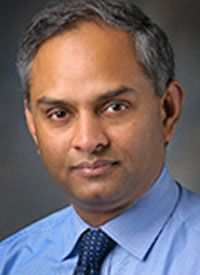Article
CAR T-Cell Therapy Continues to Show Promise in Non-Hodgkin Lymphoma
Author(s):
Chimeric antigen receptor T-cells offer highly effective therapy for patients with minimal residual disease or bulky disease in both aggressive and indolent B-cell non-Hodgkin lymphomas.
Sattva S. Neelapu, MD

Sattva S. Neelapu, MD
Chimeric antigen receptor (CAR) T-cells offer highly effective therapy for patients with minimal residual disease or bulky disease in both aggressive and indolent B-cell non-Hodgkin lymphomas, Sattva S. Neelapu, MD, said in a presentation at the 2016 Society of Hematologic Oncology annual meeting.
CAR T-cells have proved safe and effective in a variety of settings, including patients with refractory disease and after autologous or allogeneic stem-cell transplantation, said Neelapu, an associate professor of lymphoma and myeloma at the University of Texas MD Anderson Cancer Center.
Cytokine release syndrome (CRS) and neurotoxicity are the major toxicities associated with CAR T-cell therapy, but both conditions are reversible.
“Efficacy and toxicity appear to be comparable between the various second-generation CD19 CAR T-cell products,” said Neelapu. “Multicenter phase II registration trials are ongoing. Off-the-shelf allogeneic CAR T-cells and combination strategies are being tested in phase I trials, and CAR T-cells with safety switches are being explored.”
Many patients with aggressive forms of non-Hodgkin lymphoma still fare poorly with available therapies. As an illustration, Neelapu reviewed data on 635 patients with chemorefractory diffuse large B-cell lymphoma (DLBCL) included in a database comprising 2 phase III trials and 2 observational cohorts. The data showed an overall response rate of 26%, complete responses in 8% of patients, and a median overall survival of 6.6 months.
Development of CAR T-cell therapy has progressed to third-generation products, said Neelapu. Second-generation products had killing ability similar to that of the first CAR T-cell therapies developed but offered improved proliferation, cytokine secretion, and persistence.
Third-generation CAR T-cell therapies have demonstrated substantial improvement in all key parameters, as compared with first- and second-generation products. Third-generation CAR T-cell therapy involves a production process that includes 2 or more costimulation domains, whereas prior generations were based on a single costimulation domain.
Production of a patient-specific CAR T-cell therapy requires 2 to 4 weeks of manufacturing and development after apheresis or blood draw. The patients then undergo a 3-day chemotherapy conditioning regimen, usually including cyclophosphamide with or without fludarabine. The CAR T-cells product is then infused within 3 days after conditioning.
Neelapu reviewed notable studies of CAR T-cell therapy conducted to date, beginning with the 29-patient experience at the National Cancer Institute. The patients had various types of refractory B-cell lymphomas, primarily DLBCL and primary mediastinal large B-cell lymphoma (n = 17).
The treatment has led to an overall response rate of 76%, including objective responses in all five patients with indolent disease. Complete responses were achieved in 38% of patients overall, including 57% of those with chronic lymphocytic leukemia (n = 7). Neelapu said 12 patients had ongoing responses beyond 1 year of follow-up.
University of Pennsylvania investigators reported experience in 28 patients with relapsed or refractory B-cell lymphomas, primarily DLBCL and follicular lymphoma. CAR T-cell therapy led to an objective response rate of 57%, including a complete response rate of 51%.
Clinical researchers at Fred Hutchinson Cancer Research Center in Seattle have treated 32 patients with relapsed or refractory B-cell lymphomas, including DLBCL, follicular, and mantle cell. Treatment led to an overall response rate of 63%, with complete responses in 33%.
Neelapu is leading a phase I/II trial (ZUMA-1; NCT02348216) of the proprietary KTE-C19 CAR T-cell product for patients with chemorefractory, aggressive non-Hodgkin lymphoma. The phase I safety assessment involving 7 patients has been completed.
One patient had dose-limiting toxicity, consisting of grade 4 encephalopathy, grade 4 CRS, and grade 5 intracranial hemorrhage deemed unrelated to therapy. The remaining 6 patients also developed CRS, which resolved without incident in response to treatment with tocilizumab and/or corticosteroids.
Preliminary response data showed an overall response rate of 71%, including a complete response rate of 57%. Three patients had ongoing responses at 8 to 9 months of follow-up, which exceeded response duration with prior stem-cell transplantation in all 3 cases.
“The KTE-C19 regimen had a manageable toxicity profile for further study,” Neelapu said, in summarizing the results. “The study demonstrated that centralized manufacturing is feasible with a turnaround time of approximately 2 weeks.
“A single infusion of cryopreserved KTE-C19 cells achieved rapid and durable responses in patients with chemorefractory disease. Peak CAR T-cell expansion was observed within 2 weeks and persistence was observed at 1 year.”
Phase II of the ZUMA-1 trial has completed enrollment, and results could be reported as soon as the 2016 American Society of Hematology annual meeting in December.
The success of CAR T-cell therapy has given rise to a variety of novel strategies and combinations. Completed or ongoing studies are evaluating T-cells expressing CD19/CD20 bispecific chimeric antigen receptors to prevent antigen escape by malignant B-cells; CAR T-cells in combination with PD-1 checkpoint blockade; and combination strategies involving the BTK inhibitor ibrutinib (Imbruvica), the immunomodulatory drug lenalidomide (Revlimid), and the CD20 antibody rituximab (Rituxan).
Most recently, investigators have begun exploring “remote-controlled CARS,” an inducible system to control antigen receptor expression after administration. The concept could provide additional safety to the use of CAR T-cell therapy, said Neelapu.







%20(2)%201-Recovered-Recovered-Recovered-Recovered-Recovered.jpg?fit=crop&auto=format)
%20(2)%201-Recovered-Recovered-Recovered-Recovered-Recovered.jpg?fit=crop&auto=format)
